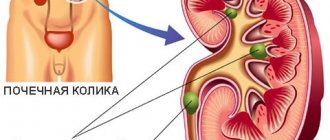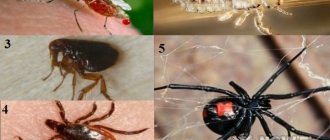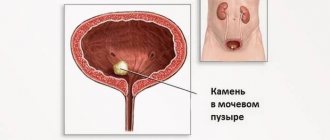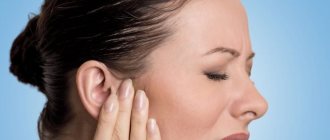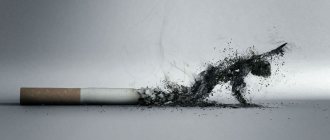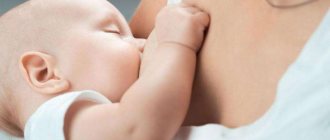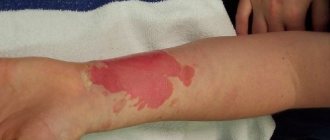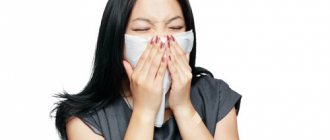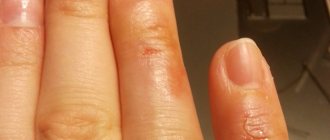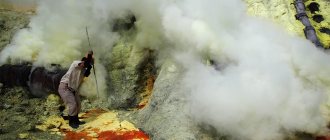Biliary colic is a symptom that is accompanied by a pronounced pain attack of an unbearable nature. The mechanism of development is due to the movement of a stone in the gallbladder, which enters the bile duct or neck of the organ.
During an attack, medical assistance is required, as it leads to painful shock. Before the team of doctors arrives, the patient’s condition can be alleviated at home by using painkillers.
Symptoms of biliary colic and the etiology of its occurrence, provision of first aid and pain relief at home, treatment - we will consider in detail.
Pathogenesis and causes of biliary colic
Biliary colic is a consequence of blockage of the common bile duct by a stone. Gallstone disease proceeds latently for years, not making itself felt until the first painful attack.
Pain syndrome is formed due to stretching of the walls of the canals and an increase in pressure in them.
Pain of an unbearable nature is observed in men and women against the background of biliary colic from several to six hours. According to statistics, the disease is most often diagnosed in women.
Etiological factors of pain attack
The main cause of pain is the movement of stones through the gallbladder and canals. A more pronounced syndrome develops if the calculus ends up in the cervical area of the organ.
The upper zones of the gallbladder are stretched to the maximum, peristalsis increases, and the flow of bile slows down or stops completely.
The following factors can lead to the development of biliary colic:
- Consumption of alcoholic beverages and fatty foods provoke contraction of the bladder and promote the movement of hard stones into the ductal system.
- Excessive physical activity, heavy lifting.
- Stress, nervous tension, neuroses.
- Constant overeating, prolonged fasting.
- Acute form of acalculous cholecystitis.
- Malfunction of the sphincter of Oddi.
- Ulcerative lesions of the gastrointestinal tract, acute appendicitis.
- Crohn's disease.
Biliary colic appears 5-10 years after the formation of stones. In some situations, pain syndrome occurs after 15-20 years.
Structure of the gallbladder and bile ducts
The gallbladder is the cavity where bile is collected and stored. The shape of the organ resembles a pear. It is attached to the longitudinal groove of the liver in the right lobe. The average volume of the bile reservoir in an adult is 70 ml. The location of the organ is under the rib on the right, where the stomach comes into contact - its superior rectus muscle with the costal arch.
The inside of the bladder is lined with muscle fibers running in a transverse direction and in a spiral. The organ consists of the body, cervical canal, and fundus. The expulsion of bile and its movement towards the duodenum along the ducts is regulated by muscle sphincters, which in medical circles are commonly called sphincters of Oddi.
The bile ducts begin to form at the exit from the liver. Moreover, two ducts are formed at once - right and left. The length of each is approximately 2 cm. Next, the ducts unite into one channel (hepatic duct) 3 cm long. Then the hepatic duct connects to the gallbladder and another duct is formed, which is also called the common duct. The length of the total flow is different for each person, but on average it is 5-6 cm (sometimes 4-12 cm).
The main task of the obstructed bile duct is to drain bile into the area of the duodenum, where the duct noticeably narrows, forming a narrow isthmus.
In this place, blockage most often occurs with solid formations, mucous accumulations, bile clots, etc., which causes a reflex spasm of the bladder.
If a person has an idea of the location of the internal organs, then this will help him, in the necessary situation, determine which organ has failed and establish the possible cause of the pain. This will help you navigate first aid (eliminate pain) to yourself or another patient.
Clinical manifestations of a pain attack
Symptoms of biliary colic can be provoked by a calculus, the migration of which is caused by other factors. The attack is similar to other pathological conditions, for example, exacerbation of a peptic ulcer or an acute form of cholecystitis.
In 99% of clinical pictures, the pain is unbearable, but in some situations the pain syndrome is moderate. However, even moderate pain is dangerous, as serious complications develop.
In adult patients, the distinctive features of an attack of biliary colic are as follows:
- First, a slight tingling sensation, followed by severe pain in the epigastric region and the liver projection area. In 1/3 of patients, biliary colic occurs at night against the background of complete rest. The pain radiates to the neck, right shoulder blade and collarbone area. The pain is similar to an angina attack.
- Fever, nausea, vomiting, increased sweating, increased temperature.
- Digestive system dysfunction, headache.
- During an attack in adult patients, the heart rate and pulse quicken, and blood pressure readings jump.
- Paleness of the skin and stickiness - cold sweat appears.
- Yellowness of the skin of varying intensity - when a stone clogs the bile duct, preventing the flow of bile.
The pain syndrome only increases after the first hour of the attack. When trying to take a deep breath, it becomes more painful, and the same thing happens if the patient tries to change position - stand up, rise, etc.
For such symptoms, home pain relief is allowed, but you need to call an ambulance for hospitalization and examination. The attack must be differentiated from renal and hepatic colic.
Baby colic clinic
Symptoms in childhood are even more pronounced than in adult patients. Gallbladder spasms in children occur due to physical activity, consumption of fatty foods, or concomitant diseases. The attack begins abruptly.
- Rapid increase in body temperature.
- Nausea.
- Indomitable vomiting (the vomit contains an admixture of bile).
- Indigestion - diarrhea, belching, heartburn.
- Feverish condition.
- There is an unpleasant taste in the mouth.
- Severe pain in the area of the gallbladder projection.
If the cause of spasm of the gallbladder is parasitic diseases, then the clinical picture is complemented by an allergic rash, itching and burning of the skin, and loss of appetite.
Differences from renal colic in symptoms
Many patients have a history of both cholelithiasis and urolithiasis. The development of a painful attack in such a situation requires differential diagnosis, allowing the correct diagnosis to be made.
Biliary and renal colic are characterized by similar symptoms, but there are certain differences:
- With biliary colic, pain radiates to the right upper limb, back and part of the chest. Against the background of renal colic, the pain radiates to the groin, inner thighs, and genitals.
- With GI, additional symptoms are changes in the color of urine and stool, and a yellowish coloration of the skin with a green tint.
- With PC, pain increases with pressure on the lower back.
The treatment of the two attacks is fundamentally different, so it is necessary to correctly determine the nature of the pain syndrome.
Symptoms of reflex spasm
The spasm occurs suddenly, more often in the evening or in the middle of the night, usually after a late, hearty dinner. A sharp, unbearable pain is localized under the right rib, where the gallbladder is located (if you draw an invisible line from the lower ribs located on the right to the nipple of the right breast exactly vertically, then we will get the exact location of the organ).
With gall bladder colic, the pain radiates to the right scapula and collarbone, and with choledocheal colic, the pain covers the area of two subcostal zones to the level of the shoulder blades (girdles). In this case, the abdomen swells, and upon palpation, unpleasant pain is noted in the area of the gallbladder. The doctor can feel a dense, painful ball (the size of the compaction can reach a decent size - sometimes the size of a goose egg) under the arch of the rib on the right.
In this case, the person feels discomfort - distension in the painful area (usually in the liver area). Patients describe their condition as if they were tied with a tight belt, which they immediately want to unfasten, take a deep breath and at the same time lean forward. Such symptoms are characteristic of cholelithiasis.
As for dyskinesia or giardiasis, the symptoms are not clearly defined, the pain is moderate, which, in principle, can be tolerated.
Worst of all, when the patient has a concomitant disease, namely angina pectoris or other diseases of the cardiac system, then the pain can radiate to the cardiac region and thereby worsen the condition of the heart muscle (exacerbate the disease) and the person’s well-being.
Other symptoms characteristic of spasm:
- attacks of nausea;
- profuse salivation (pronounced in the presence of Giardia in the liver);
- vomiting with or without bile (typical of cholelithiasis);
- the temperature rises sharply, accompanied by severe chills (a direct symptom of stagnation of bile and inflammation in the bladder);
- feeling of bitterness in the mouth.
You should also consider the different types of pain and symptoms that occur against the background of various diseases. So, for example, with choledocheal colic against the background of cholelithiasis, pain syndrome that does not go away for a long time (6 hours or more), jaundice occurs.
If we consider the pain that occurs with acalculous cholecystitis, it can be characterized as follows. The spasm begins suddenly. After some time, the pain subsides a little, but at the same time becomes permanent.
- A slightly elevated temperature (37.2 or slightly higher) may be normal;
- The muscles in the area of the right hypochondrium are tense;
- With palpation (light tapping), the pain intensifies;
- ESR levels and leukocytes in the blood increase.
With inflammation of the bile ducts, there is a so-called triad of symptoms:
- pain under the rib on the right;
- the temperature rises;
- a yellowish tint appears on the skin, sclera of the eyes and mucous membranes.
In severe cases of the disease, the following symptoms may be added to this list: bloating, confusion and short-term loss of consciousness (during an attack, when a sharp stone begins to move along the passage, a person may lose consciousness from pain). In addition, there is a decrease in blood pressure, stool becomes discolored (takes on the color of gray clay), urine takes on an unnatural shade (resembles the color of beer).
Emergency care before the ambulance arrives
The first action when biliary colic develops is to call an ambulance. Before the arrival of medical specialists, a person can be given first aid - remove tight clothes from him, expose the area of \u200b\u200bthe ribs and abdomen.
It is better for the patient to be in a horizontal position, on the right side - so the attack of pain is not so acute. For severe pain, take a painkiller tablet. Atropine (an antispasmodic) is used to relieve spasms of smooth muscles. You can use combination drugs - Spazgan. When the pain is completely unbearable, the strong medicine Tramadol is recommended.
How to relieve hepatic colic - first aid
While waiting for the doctor to arrive, the patient can receive emergency care at home. The main task is not to aggravate the person’s condition or increase the pain syndrome. It is strictly prohibited:
- apply a heating pad to the right hypochondrium;
- engage in any activities, physical activity is contraindicated during an attack;
- press on the area with painful sensations;
- eat food, drinks, it is only allowed to drink clean water in small quantities;
- take any medications whose effectiveness is not certain.
The help algorithm is as follows:
- Provide the patient with rest. He should lie either on his back or on his right side. There is no need to force him to lie in a way that is uncomfortable for him. It is better to be in a quiet, calm environment.
- Use an antispasmodic. Papaverine, No-Shpa, Promedol are considered effective. To relieve spasms faster, it is better to give an injection based on these drugs rather than take them orally.
- Provide fresh air. The patient must breathe calmly so that the nervous system calms down.
Usually, a gastroenterologist diagnoses and prescribes treatment for hepatic colic; if the attack is not severe, you can take the patient to the clinic on your own
Then you just have to wait for the doctor or ambulance to arrive. In most cases, acute attacks require hospitalization in order not only to relieve hepatic colic, but to establish its cause and select effective therapy.
Diagnosis and principles of treatment of biliary colic
To make a correct diagnosis, laboratory tests of urine, blood, hardware ultrasound, CT, MRI, plain radiography, cholecystography, MRI and CT of the gallbladder are prescribed.
It is imperative to differentiate biliary colic with such diseases as pancreatitis, gastric ulcer, duodenal ulcer, acute appendicitis.
Upon admission of the patient to a medical institution, a physical examination is carried out, and special attention is paid to the medical history - the presence of cholelithiasis, a chronic inflammatory process in the gallbladder. A characteristic sign of GI disease is that the patient is forced to lie on his right side, pulling his legs towards himself - this way the pain syndrome becomes somewhat weaker.
The main diagnostic method that helps evaluate the affected organ is an ultrasound examination of the gallbladder and its canals, and the liver. Laboratory tests show an increase in ESR; in more than 70% of patients, urine amylase increases.
How is colic treated?
During an attack, medications are used to neutralize bile spasms and stop a painful attack. Fasting is required - duration is 48 hours. This recommendation allows you to reduce the load on the gastrointestinal tract, gallbladder and liver, and prevents possible complications.
To alleviate the patient's condition, medications are prescribed:
If the patient's condition does not improve, then metoclopramide is included in the treatment regimen. When the drug does not have an effect for 5-6 hours, the pain syndrome persists, it is necessary to transfer the patient to surgery, where surgical therapy is prescribed.
Emergency intervention is recommended in cases where the results of the study show a high risk of perforation of the gallbladder, the likelihood of purulent complications.
Carrying out cholecystectomy
The presence of stones in the gallbladder is dangerous, since they can begin to migrate at any moment. Poor nutrition, stress, nervous tension, physical fatigue - all this contributes to the movement of stones into the cervix and organ channels.
The operation involves removing the gallbladder and its contents – solid inclusions. Traditionally, two types of cholecystectomy are performed - from the neck (through ligation and subsequent excision of the cystic canal and artery) and from the fundus (in cases where it is not possible to access the canal directly).
Sometimes laparoscopic cholecystectomy is done - surgical access is obtained by puncturing the abdominal wall. The most commonly used technique is when the doctor makes 4 punctures: 2 are 0.5 cm long, and two are 1 cm long. A special instrument is inserted into the abdominal cavity, a laparoscope - a device that displays a three-dimensional image on the monitor.
After a classic operation, the patient spends several days in the intensive care unit, where medical supervision is provided 24 hours a day. After laparoscopic intervention, the patient is immediately transferred to the general ward (if there are no complications).
Drug therapy is carried out - antibiotics and a number of other medications are prescribed to promote rapid recovery. The patient needs to follow a diet, reduce physical activity, and periodically visit a doctor to check for the development of complications.
Approximately 40% of patients after removal of the gallbladder develop postcholecystectomy syndrome - a pathological condition accompanied by symptoms that were present before the intervention (phantom pain, etc.).
Hepatic colic: symptoms in women
The symptoms of colic in the liver are very characteristic and recognizable. Usually, in a relative state of rest, the patient feels a strong unexpected pain on the right under the ribs, in the projection of the liver or gallbladder, sometimes in the epigastrium. The pain immediately increases, takes on a tearing, stabbing character, forces the patient to take a lying position, but this does not bring relief.
With hepatic colic, the pain is most often localized on the right under the ribs
A person cannot find a place for himself, he cannot find a comfortable position, he rushes about in search of a comfortable position that will calm down the pain. Most often, the patient finds himself in this position: he lies on his right side, pulls his legs to his stomach and freezes. It is not uncommon for colic pain to radiate to other areas: the heart, ribs, collarbone, neck, or shoulder.
Severe radiating pain during colic is due to the fact that the bile ducts have very sensitive nerve endings that become irritated at the slightest problem. At the same time, the endings calm down just as quickly - the discomfort can go away in ten to fifteen minutes. However, an attack can last for a very long time, from five to seven hours, without stopping, to a day with short breaks.
Also, a number of symptoms of hepatic colic include:
- Minor vomiting that does not bring relief (most often the patient vomits bile).
- Bloating, flatulence.
- The skin is pale (in some cases a yellowish tint to the face and neck), the patient sweats moderately.
- Whitish stool, dark urine.
- Hyperthermia (temperature rises to 38 degrees, rarely higher).
Bloating, flatulence - symptoms accompanying hepatic colic
If these symptoms take on a hypertrophied character - vomiting becomes uncontrollable, the temperature rises above 39 degrees, the person shudders, the pain increases to the point of shock, perhaps neighboring organs have become involved in the pathological process. Inflammation of the pancreas or obstruction of the excretory tract of the gallbladder often occurs simultaneously with hepatic colic, dramatically making the patient’s condition extremely serious.
Video - First signs of liver disease
Prevention
It is impossible to predict what exactly will provoke a painful attack. Therefore, prevention includes many activities. Thus, the patient is recommended to follow a dietary diet (table No. 5), avoid alcohol, smoking, and excessive physical activity.
To improve the functionality of the gallbladder and liver at home, you can use folk remedies. According to reviews, a decoction with milk thistle gives a good effect - pour 250 ml of boiling water into a tablespoon, leave for several hours, and filter. Drink 50 ml three times a day. Milk thistle is also sold in tablets, taken according to the instructions.
General information
Biliary colic is a pathological condition accompanied by acute sharp pain in the right hypochondrium. As a rule, it is a signal of cholelithiasis , other pathologies of the gallbladder and biliary tract, which account for up to 11% of the total number of disorders of the digestive system.
A little about hepatic colic
According to medical statistics, a gallbladder attack in adults most often occurs as a result of a violation of the outflow of bile during cholelithiasis, provoked by obstruction of the organ duct with formed stones.
This condition is accompanied by prolonged intense pain in the right hypochondrium and repeated vomiting. The intensity of the pain symptom largely depends on the size of the stone and its location. In the absence of an inflammatory process and when the stone is located in the body or bottom of the gallbladder, pain does not occur. If the stone is located closer to the neck of the organ, pain of minor intensity may be felt.
Hepatic colic is closely related to disorders of the gallbladder and in almost 75 percent of patients is the onset of cholelithiasis. Hepatic colic with its repetitions is observed in every ten patients with cholelithiasis. With age and as the asymptomatic nature of cholelithiasis develops, the likelihood of hepatic colic increases. Fifteen years after the formation of gallstones, attacks occur in a quarter of patients.
The cause of the formation of hepatic colic is most often an irritating factor in the form of eating fatty and spicy foods, which promotes spastic contractions of the walls of the gallbladder and the advancement of stones into its ducts. As a result of obstruction, the free outflow of bile is disrupted, which results in an increase in intravesical pressure, accompanied by severe pain.
Hepatic colic can manifest itself during physical overexertion, at the time of increased psycho-emotional state, during the period of bearing a child. In some cases, the factor that provokes the development of hepatic colic is not determined. A third of patients note the appearance of attacks at night. In the case when the manifestation of colic occurs against the background of inflammation, one can judge the acute form of calculous cholecystitis.
Pathogenesis
Biliary or hepatic colic (ICD-10 code: K80.5) is most often preceded by cholelithiasis , which results in a violation of the outflow of bile, the formation of sand, stones, mucus plugs - cholelithiasis and, as a consequence, blockage of the biliary system - intrahepatic and / or general ducts (choledocholithiasis). Biliary pain occurs as a result of obstruction of the biliary tract (partial or complete blockage), associated with an increase in pressure in it and, as a result, expansion and spasm of smooth muscles.
When gallstones are in the body or at the bottom of the gallbladder, the pathology does not have a clinical picture, but movement along the cystic ducts causes an attack of hepatic colic and the possible addition of an infection. Depending on where the stone stops dropsy , empyema , peritonitis , and perforation . cholangitis develop .
With choledocholithiasis the Villar triad is usually observed - biliary colic, fever and jaundice . In cases of sudden blockage of the bile ducts, there may be no infection and, as a result, no increase in temperature.
What causes can cause biliary and hepatic colic?
The main cause of hepatic and biliary colic is associated with a violation of the process of bile discharge. Pathological changes in the liver parenchyma may also occur. But they most often cause dull, constant pain of a non-acute nature.
Among the most likely causes of biliary colic, the following factors are worth noting:
- blockage of the lumens of the ducts with stones;
- massive helminthic infestation;
- acute inflammatory processes;
- physical and nervous stress.
Hepatic colic does not occur spontaneously, without an existing serious illness. Possible pathologies include:
- cholelithiasis;
- inflection of the gallbladder;
- hepatosis;
- cirrhosis of the liver;
- cholecystitis;
- duodenitis.
Causes
Various pathologies of the liver and biliary tract can provoke the development of biliary colic, these include:
The provoking factors of biliary colic are:
- sudden movements and heavy lifting;
- consumption of fatty, fried, spicy, smoked or too spicy foods, as well as other errors in the diet;
- alcohol abuse;
- sedentary lifestyle;
- age over 40 years;
- taking hormonal estrogen-containing drugs;
- cases of mental, physical strain and stress ;
- work and other activities in a bent position.
Prevention of hepatic colic
Since colic most often occurs against the background of an incorrect regimen and rhythm of life, the prevention of this disease plays an important role. Along with the prescribed treatment, the patient must follow other rules:
- Avoid inactivity (moderate sports activities, walking, swimming are required).
- Review your diet in favor of proper balanced nutrition, giving up fast food, heavy and junk food, smoking, and drinking alcohol.
- Take meals in fractions, five to six times, eating in small portions.
- Women should stop taking oral contraceptives and replace them with condoms.
- Adjust weight: gently lose extra pounds if you are obese or gain the missing weight.
Sports and proper nutrition are the best prevention of hepatic colic
Symptoms of biliary colic
The main symptoms of hepatic colic are sudden and sharp severe pain that arises under the right rib, which can spread (radiate) throughout the abdomen and reach the interscapular space and the right shoulder. Biliary colic can last several hours (about 2-6) and, unlike other types of colic and pain, does not change its intensity. The nature of the pain syndrome is stabbing, cutting and tearing, and may be accompanied by:
- fever (temperature rises to low-grade);
- chills;
- skin itching;
- change in the color of urine, towards darkening due to the presence of bilirubin and discoloration of feces - due to the lack of urobilin ;
- development of yellowness of the skin after 12-24 hours;
- nausea and bouts of vomiting, and bile may be present in the vomit;
- taste disturbances – dryness and bitterness in the mouth;
- bloating;
- dyspeptic disorders, heaviness, flatulence and stool instability;
- restlessness and agitated behavior with screams, moans and a desire to rush from side to side.
Hepatic colic in men can be combined with signs of heart failure: shortness of breath , cyanosis , tachycardia , arterial hypotension , and signs of microcirculation disorders such as “marbled skin color.” Due to spastic contractions of the sphincters, increased intravesical pressure and overstretching of the walls of the gallbladder, pain may be aching and weakened.
Symptoms of hepatic colic in women usually do not differ, but occur 2-3 times less often, despite the fact that the female body is more predisposed to the formation of stones.
Main symptoms
Symptoms of biliary colic without experience and knowledge can be confused with an exacerbation of other gastrointestinal diseases, for example, peptic ulcer or acute cholecystitis. Sometimes an attack is not accompanied by severe pain, which confuses people and even doctors. But any pain syndrome in the area of the epigastrium and right hypochondrium in the presence of stones is a reason to first of all contact a gastroenterologist or therapist, undergo an ultrasound scan and get tested. Even with mild pain, complications can occur, many of which are very dangerous.
Distinctive signs of biliary colic:
- pain in the right hypochondrium and epigastrium is sharp, unbearable, in a third of cases it appears against the background of complete rest at night, radiating to the right shoulder blade, collarbone and neck;
- the pain syndrome may feel similar to an angina attack, but heart medications do not help, nausea and vomiting of bile additionally appear;
- yellowness of the skin occurs when a duct is blocked by a stone.
The pain gradually subsides. For many people with calculous cholecystitis and cholelithiasis, colic goes away within 20-30 minutes even before going to the doctor. But this doesn't always happen.
Colic pain is most intense in people with numerous small stones. They greatly stretch the gallbladder, causing a reflex spasm of the bladder and the walls of the ducts, and an unbearable acute pain syndrome.
Tests and diagnostics
To establish a diagnosis of hepatic colic, the attending physician needs to study the clinical picture and individual characteristics of the patient’s condition. Patients usually experience obesity , xanthomatosis and xanthelasmas (the presence of yellowish lipid deposits on the skin), areas of hyperesthesia , dry mucous membranes of the mouth and tongue, bloating, tension in the muscles of the abdominal wall, cystic and other symptoms , including Ortner, Murphy, Coeur, Mussy . When palpating the area located in the projection of the gallbladder, painful sensations occur.
If gallstone disease is suspected, it is necessary to conduct ultrasound examinations of the liver with the gallbladder, duodenal intubation, and radiography to detect gallstones or calculi.
The list of additional examinations usually includes:
- blood tests to detect leukocytosis , increased ESR , hyperbilirubinemia , increased activity of alkaline phosphatase, nucleotidase, γ-glutamyl transpeptidase , increased amounts of cholesterol, triglycerides, β-lipoproteins, γ-globulins ;
- a general analysis of urine samples, which usually demonstrates significant bilirubinuria ;
- culture of bile to identify the infectious process.
Diagnosis of hepatic colic
If the hospital where the patient is admitted has a gastroenterology department, then he will be sent there; otherwise, he will be sent to surgery. The fact is that the symptoms of hepatic colic may in fact indicate acute cholecystitis, dropsy, perforation of the gallbladder - all this indicates the need for immediate surgery.
Gallbladder perforation
First of all, the doctor will interview the patient, finding out from him not only the symptoms that are currently bothering the person, but also finding out whether something bothered him earlier. 95 percent of people hospitalized with a preliminary diagnosis of hepatic colic have a history of pain under the ribs on the right after a heavy dinner, drinking alcohol, complaints of upset stool, permanent nausea or heaviness in the stomach.
Palpation is one of the types of examination for hepatic colic
With hepatic colic, palpation of the patient's abdomen gives characteristic results. With rhythmic pressure on the abdomen, muscle protection syndrome is activated, when the anterior abdominal wall tenses, and Kehr's syndrome is also determined (on inspiration, when palpated in the area of the gallbladder) and the Grekov-Ortner sign (when the edge of the palm is tapped on the ribs on the right). Also, a person will instinctively hold their breath when the doctor presses deeply on the gallbladder projection.
In addition to palpation, a number of other, more accurate and informative studies, using computer technology and in the laboratory.
Table 2. Tests required to diagnose colic in the liver
| Name of procedure | How does the procedure work? |
| Biochemical tests of urine and blood | Urine is given as standard, in a sterile container, blood is taken from a vein. The study is necessary to understand the process of excretion of the pigment bilirubin, which leaves along with bile. |
| Ultrasound | A quick and safe study that shows stones in the ducts, pathologies of the liver, and gallbladder. For the procedure, the patient undresses to the waist and lies down on the couch. A gel is applied to the right area of the abdomen for better conductivity and a sensor is moved over the skin; information about the internal organs appears on the screen in real time. |
| CT | If the ultrasound did not turn out to be informative enough or did not reveal stones, the patient undergoes a computed tomography scan, which allows the size of the organs and changes in them to be seen in detail. To do this, a person lies down inside a special device, where he must remain motionless for about ten minutes. |
| ERCP | This procedure is a symbiosis of radiographic and endoscopic examination. A contrast agent is injected into the liver area through a thin tube, which, with X-rays, clearly outlines the ducts and the location of the stones. If necessary, small stones can be removed immediately using an endoscope. The procedure does not require general anesthesia; the patient is only given a sedative “cocktail” intravenously. |
Ultrasound is considered the “golden method” for identifying problems with the gallbladder and liver
You need to understand that with confirmed hepatic colic, cholelithiasis or other complication, the person will remain in hospital treatment. In this case, doctors will select a complex multi-component treatment, including painkillers, droppers with solutions to normalize the water balance. The patient will remain under observation for some time; if his condition does not normalize, a decision may be made on surgical intervention.
Treatment of biliary colic
For acute pain in the right hypochondrium, the patient requires hospitalization. analgesics and antispasmodics are prescribed to relieve pain .
Emergency care and relief of an attack of biliary colic comes down to the administration of peripheral M-anticholinergics, myotropic antispasmodics . nitroglycerin (0.005 g sublingually) helps to cope with the syndrome If there is no effect, further treatment of hepatic colic requires the prescription of non-narcotic analgesics, and then narcotic drugs. , perinephric blockade helps to cope with colic .
If a patient has an inflammatory infectious process, broad-spectrum antibiotics ( tetracyclines ) may be indicated; if a coccal infection is detected, furazolidone , rod - biseptol , mixed - trichopolum .
- Pain in the epigastric region
- Fever
- Yellowing of the skin
- Spread of pain to other areas
- Vomiting bile
- Nausea
Biliary colic is a clinical sign that is characterized by pronounced pain, often unbearable. A pain syndrome of this nature manifests itself at the moment when a stone located in the gallbladder enters its neck or cystic bile duct.
An attack of biliary or hepatic colic requires urgent medical attention, as it can lead to painful shock. Before the medical team arrives, the patient must be given first aid.
According to the International Classification of Diseases, tenth revision, an attack of biliary colic belongs to the section of cholelithiasis, which is why the ICD-10 code will be K80.
Gallbladder attack in a child
When there are disorders in the gallbladder, bile stagnation occurs, which, if this condition develops in children, manifests itself with insufficiently pronounced symptoms. Typically, a child may experience a gallbladder attack with hypertonic, hypotonic or mixed forms of congestion.
Hypertensive stagnation, caused by increased contractility of the gallbladder and ducts, is usually accompanied by acute pain in the right hypochondrium, most often occurring after increased physical activity of the child. In this case, children may experience nausea, vomiting, frequent bowel movements and diarrhea, loss of appetite, accompanied by headaches and weakness. This form is more often found in teenage children.
The hypotonic form of bile stagnation with an attack of colic in children is less common, as it is caused by a decrease in the contractility of the gallbladder ducts and its walls. As a result, the liver enzyme accumulates, stretching the walls of the gallbladder, which is accompanied by pain.
The mixed form contains symptoms of these two conditions. Usually the child loses his appetite, but does not lose weight, but, on the contrary, gains weight due to swelling of the limbs and face. In this case, the skin suffers; the child scratches the skin vigorously, leaving scratches on it. Severe itching causes anxiety, his character changes, he becomes capricious and nervous.
Etiology
It should be noted that an attack of biliary colic can be caused not only by cholelithiasis, but also by other diseases in the genitourinary system. Thus, clinicians identify the following etiological factors for the development of such an attack:
- functional disruption of the gallbladder;
- dysfunction of the sphincter of Oddi;
- exacerbation of chronic acalculous cholecystitis;
- acute acalculous cholecystitis;
- formation of stones in the common bile duct;
- acute form of cholangitis;
- acute appendicitis;
- Crohn's disease;
- ulcerative lesion of the stomach.
Who said that it is impossible to cure severe gallbladder diseases?
- Many methods have been tried, but nothing helps.
- And now you are ready to take advantage of any opportunity that will give you the long-awaited well-being!
An effective treatment for the gallbladder exists. Follow the link and find out what doctors recommend!
Biliary colic always begins suddenly. In this case, the person experiences severe paroxysmal pain under the rib on the right or in the stomach area. Pain syndrome is caused by blockage of the bile ducts. The pain occurs due to the stone entering the cervical organ, the duct is blocked. This causes an increase in pressure inside the bladder, resulting in a powerful reflex spasm, accompanied by intense sharp pain.
To understand the causes and mechanisms that cause spasms, you need to have some understanding of the structure of organs.
Symptoms
An attack of biliary colic has a pronounced symptom complex, so an experienced doctor, as a rule, has no problems making a diagnosis. It should be noted that due to the structural features of the body, women experience an attack of pain in the area of the gallbladder of this etiology more often than men.
An attack of hepatic colic is characterized by the following symptoms:
- The attack begins abruptly and is characterized by severe unbearable pain. Most often, the attack begins abruptly and after eating fatty, heavy foods, after drinking alcoholic beverages or excessive physical exertion;
- during the first hour the pain only increases;
- the attack lasts from two to six hours. If after this time the pain does not go away, then this may indicate an attack of acute cholecystitis;
- the pain is localized above the navel and radiates to the back and right rib. Often gives to the right hand;
- when trying to take a deep breath or during physical activity, the pain intensifies;
- yellowness of the skin;
- elevated temperature;
- nausea and vomiting, with bile present in the vomit.
Separately, we should highlight the nature of the pain syndrome that is characteristic of this attack:
- acute, paroxysmal;
- localized in the epigastric region, radiates to the right side, arm, and the entire back;
- in some cases it radiates to the sternum, which will be similar to an attack of angina pectoris.
If the root cause factor is not eliminated, the attack will recur with varying frequency. You also need to understand that as the pathological process worsens, the frequency of attacks will increase, and the symptoms will be more pronounced.
Drug therapy
Antispasmodics are used to relieve spasms of the muscular structure of the organ.
The root cause of colic is a spasm of the muscular structure of the organ. It needs to be removed and for this a number of effective antispasmodics are used: “Platifilin”, “Drotaverine”, “Promedol”, “Papaverine”, “Baralgin”, “Atrapin” and “No-shpa”. Moreover, it is necessary to use strong painkillers and non-steroidal anti-inflammatory drugs aimed at reducing pain spasms. The most popular are Ketorolac and Metamizole. For acalculous colic, injections of Cholicystokinin and Pancreozemin are prescribed.
Standard procedure for drug administration:
- 1 milliliter of Atropine 0.1% solution with 1 milliliter of Promedol;
- 2 milliliters of No-shpa with 5 milliliters of Baralgin.
For higher effectiveness, injections must be administered intramuscularly. If the spasm does not stop within several hours, the situation worsens and acute cholecystitis occurs. Its therapy requires a different course of treatment using other medications prescribed by the attending physician.
Drug therapy is usually prescribed for a long time (up to three months), after which the patient is examined again. Next, the attending physician either completely cancels the course of drug therapy or prescribes a new one.
Diagnostics
As a rule, the clinical picture of biliary colic syndrome does not raise doubts about the diagnosis. However, to establish the root cause factor, some diagnostic measures are required, namely:
- physical examination of the patient with collection of personal history;
- Ultrasound of the liver, gallbladder, pancreas;
- duodenal intubation;
- UAC and BAK.
Depending on the current clinical picture, the diagnostic program can be adjusted. In general, the program of diagnostic measures is compiled on an individual basis.
Taking into account the signs of an attack and the data collected as a result of research, the doctor can determine the primary source of this person’s condition and determine the most effective treatment tactics. Self-medication, even through traditional medicine recipes, is unacceptable, as this can cause not only serious complications, but also death.
Prevention and diet
An excellent preventive measure is moderate physical activity - walking, morning exercises, cycling, swimming.
Spasms can be prevented by consuming medications, foods or herbs with a choleretic function - corn leaves, birch leaves, agrimony . Prophylactic choleretic substances should be used on an empty stomach. After this, it is recommended to lie down on your right side for a while, applying a warm heating pad to it. But before starting such prophylaxis, it is necessary to consult with a specialist, since such prophylaxis is not suitable for people who have been diagnosed with calcified stones.
To reduce the risk of pathology, dietary ration No. 5 is prescribed. This diet is based on the most optimal composition of nutrients. Biliary colic is not combined with the following products:
- Fried foods.
- Cocoa.
- Coffee.
- Sorrel.
- Tea.
- Spinach.
- Sour vegetables.
It is recommended to consume the following products:
- Lemons.
- Rhubarb.
- Olives.
- Grapefruits.
- Coriander.
- Olive oil.
Meals are divided into small portions, but it is recommended to eat more often - 5-6 times a day. The temperature of the food should be at room temperature. Deviations from it are not allowed. The diet and products are prescribed by a doctor.
A very important point is the timely treatment of gallstone disease, in which it is necessary to remove stones from the ducts.
Avoiding stressful situations, maintaining a healthy lifestyle , maintaining a healthy diet and getting rid of bad habits will help prevent the risk.
The combination of preventive procedures along with a well-prescribed therapeutic course helps to minimize the risk of spasm formation.
A person must understand that bile spasms are a sign of serious disorders in the body, which without proper medical treatment can lead not only to dangerous complications, but also to death. Experts strongly advise against self-medication. If symptoms appear, you should immediately seek medical help.
Treatment
In addition to the main course of treatment, which is prescribed by the doctor after the examination, at home the patient needs to provide first aid for biliary colic to prevent the development of pain shock. Based on this, it becomes clear that the main goal is to relieve pain with the help of antispasmodics or painkillers.
If there is no doubt that these are attacks of biliary colic, the patient can apply a heating pad to the area of the right hypochondrium. If the clinical picture of the attack is ambiguous, it is strictly forbidden to do this, since in some diseases, heating can only do harm.
Patients with this diagnosis must be hospitalized in the surgical department, since in addition to special treatment they require nursing care.
If the cause of such an attack is cholelithiasis, then treatment, in most cases surgical, involves surgical removal of stones from the gallbladder.
The medicinal stage of treatment may include the following drugs:
The dosage and method of use are strictly prescribed by the attending physician; such drugs cannot be used without permission.
In addition to drug treatment, the patient is prescribed a diet. The specific dietary table is determined individually, but in any case you will need to adhere to the following recommendations:
- Fatty, spicy foods are excluded from the diet. Also prohibited are sour, salty, fried foods;
- the patient’s diet should be light, but at the same time sufficiently high in calories;
- consistency of dishes – liquid, puree, grated;
- food should be consumed only warm;
- The patient’s meals should be frequent, but in small portions, with a time interval of 2-3 hours;
- drinking plenty of fluids. Herbal infusions, weak green tea, and still mineral water are recommended.
The pharmacological group of drugs and the regimen for taking them is determined only by the doctor.
The prognosis will depend on the primary source of the attack of hepatic colic. However, in any case, the sooner treatment is started, the greater the chances of recovery; in addition, the risk of complications is minimized.
How to relieve pain due to gallbladder spasm
Before the ambulance arrives, a person can independently apply some methods to alleviate his condition and relieve severe pain. To relieve spasms, you can take a warm, relaxing bath, and then apply a heating pad with ice to the painful area. If you have pain, you should not eat food, and you should also stop drinking. Taking a deep breath tends to increase pain, so you should not breathe deeply. Gentle pressure on the painful area helps a lot, and when the pain becomes tolerable, you can stop such actions.
Important! You cannot put a hot heating pad on your stomach! You should also know that it is not always possible to take choleretic drugs to prevent dislodged sharp small stones passing through the passages from tearing the membrane of the bladder or bile ducts. This may be fatal (death of the patient).
The patient should loosen tight clothing (unbutton the collar, remove the tightening belt, etc.), lie down on one side (right), and relax as much as possible. If there are no contraindications, then you can put a nitroglycerin tablet under the tongue (it helps relieve severe pain for a while). You should know that taking solid dosage forms (tablets) orally for biliary colic usually causes a gag reflex. Although inducing vomiting in many cases helps relieve severe pain and they are even induced specifically for this purpose.
When a person cannot take nitroglycerin, then you can use holagol (red drops). You need to drop 2-5 drops onto a piece of refined sugar and suck slowly. The pain usually stops after this. Validol and menthol have the same effect, so you can chew gum or slowly dissolve any candy that contains menthol and mint. Naturally, such drugs do not have strong analgesic properties, but they are still capable of slightly alleviating the patient’s condition.
It is recommended to relieve cramping pain with antispasmodics; you can use strong painkillers. Taking antispasmodics (“No-shpa”, “Drotaverine”, “Papaverine”, “Duspatalin” and others) will help relieve spasm of smooth muscles. Combined-action drugs (antispasmodic and analgesic) – “Spazgan”, “Bral” and others - are good for pain relief. Before using medications, you must carefully read the contraindications and dosage.
Patients benefit greatly from tea with mint or a decoction of valerian roots, sweetened with honey, which is drunk before bed. It is not recommended to use alcohol tinctures; it is better to prepare the product from dried plant materials. Prepare this way: 1 hour. a spoonful of dry plant material per 250 ml of boiling water - brew (you need to simmer for a few minutes over low heat), leave and drink at night. When colic does not go away and the symptoms increase, it is necessary to urgently call an ambulance or go to the hospital (surgical department).
Symptoms
Symptoms of a gallbladder attack depend not only on the underlying disease, but also on its stage and form. Pathologies with an acute course are manifested by pain on the right under the ribs, which spreads to the upper part of the body (back, shoulders, collarbone). Many patients complain of digestive disorders in the form of nausea or vomiting. In addition, muscle tone on the right side of the abdomen increases.
Many patients are interested in what symptoms are characteristic of a particular disease that provokes biliary colic:
- Acute cholelithiasis is manifested by pain on the right under the ribs if the rules of nutrition are not followed, itching of the skin, fever up to 40°, chills, and excessive sweating.
- With chronic cholecystitis, there is discomfort in the right hypochondrium, aching pain after breaking the diet, itching of the skin, and sometimes the temperature rises.
- Violation of the contraction of the gallbladder, as well as its ducts, is manifested by periodic pain (about 15 minutes) when the pressure of bile increases. When the pressure of the liver secretion decreases, the patient complains of aching pain in the right side. In addition, the temperature rises to 38°.
- When the bile ducts become inflamed, intense paroxysmal pain occurs, due to which the patient may lose consciousness. Many patients experience itchy skin, fever (up to 40°), chills, and excessive sweating.
- Malignant formations provoke aching pain on the right under the ribs and fever from 37.5 to 38°.
These signs do not appear immediately; this likelihood increases when the patient regularly violates the diet and leads a passive lifestyle.
First, the contraction of the gallbladder, as well as its ducts, is disrupted, stagnant processes occur, bacteria begin to develop in the organ cavity, and an inflammatory process develops. Damaged gallbladder cells precipitate in the form of flakes, bile pigments settle on them, and as a result, stones are formed. Over time, the size of the stones increases, they clog the bile ducts, after which pain occurs.
Doctors identify common symptoms of biliary colic:
- paroxysmal pain on the right under the ribs and in the epigastrium;
- excessive sweating;
- increased heart rate;
- severe headache;
- bowel disorders (constipation alternating with diarrhea);
- sleep disturbance.
A reflex spasm is manifested by nausea, copious salivation, eruption of vomit with or without bile, and bitterness in the mouth. With spasm of the bile duct due to cholelithiasis, the pain does not disappear for 6 hours, and the skin and mucous membranes turn yellow. With acalculous cholecystitis, the attack occurs abruptly, and then subsides a little, and the pain becomes constant.
In severe cases, flatulence occurs, hypotension occurs, feces become discolored, urine darkens, and the patient loses consciousness for a short time.
If such symptoms occur, you should visit a doctor.
Video
3 ways to relieve colic due to cholelithiasis.
Gallstone disease is a serious disease that affects a quarter of men and women. Some people learn about the onset of the disease on the operating table. Biliary colic is a complication of gallstone disease that causes severe attacks of pain. During colic, a person can lose control of himself due to severe pain, body temperature and blood pressure rise. Vomiting may begin. Providing timely assistance is a chance for surgical treatment and life. Let's try to understand the causes and symptoms of the disease, and consider how the diagnosis is carried out.
Treatment methods
When symptoms of biliary colic appear, the patient should be treated in a hospital, since it is difficult to predict the course of the disease and its complications. The presence of a stone in the biliary tract is an indication for emergency hospitalization.
Before emergency doctors arrive, you need to know how emergency care is provided for biliary colic. This will only alleviate the patient’s condition. If symptoms of gallbladder spasms appear, it is recommended to lie on your right side.
Attention! Under no circumstances should you place a hot heating pad on your stomach, as you will not know what exactly is causing the pain. If a person has purulent inflammation in the abdominal cavity, warming the area will lead to peritonitis.
If your home medicine cabinet contains antispasmodics (for example, No-Shpa, Spazgan or Buscopan), give the patient one tablet. This will relieve spasm of the bile ducts, and perhaps the stone will pass into the intestines on its own. Taking analgesics (Nurofen, Diclofenac) is strictly prohibited, as this will blur the picture of the disease, and it will be difficult for doctors to make a correct diagnosis.
Peppermint tincture will also help relieve pain. This herbal preparation has a relaxing effect. Nothing else can be done at home. Some patients take choleretic drugs. This will cause the amount of bile to increase, stretching the gallbladder further.
Drug therapy
After hospitalization in the surgical department, the patient will be prescribed conservative therapy: antispasmodics, anti-inflammatory drugs, painkillers, antibiotics. If severe dehydration has developed due to vomiting, IV drips will be prescribed.
The principle of treatment lies in three words: cold, hunger and peace. The patient cannot eat, only drink water. An ice pack is placed on the right side. In this way, the doctor will prepare the patient for surgery.
Surgical methods
Surgical assistance for an attack of biliary colic consists of removing the stone and restoring the outflow of bile. During ERCP, the stone is captured and removed through the papilla of Vater. If it is very large, mechanical or laser crushing of the stone is used, after which the crushed fragments are removed. If it is not possible to remove the stone, the gallbladder is removed - cholecystectomy.
To reduce pressure in the bile duct system, a gallbladder puncture is performed under ultrasound guidance. A long needle pierces the wall of the bladder and removes excess bile. After this procedure, the patient's condition immediately improves, and they can be prepared for more invasive procedures.
Treatment of the disease
Treatment of biliary colic begins with an accurate diagnosis of the cause that caused them. Depending on it, treatment will be prescribed. For diagnostic purposes, ultrasound examination, radiography, general urine and blood tests are used.
Cholelithiasis
If stones of various sizes are found in the gallbladder or ducts, their removal is indicated. For small lesions, conservative methods are used. They involve the use of drugs that break down stones. If the stones are up to 2.5 centimeters in size, ultrasonic or laser crushing is allowed. When there is a large accumulation of stones and disruption of the gallbladder, surgical intervention is used. Acute or chronic cholecystitis. The main treatment is to follow a proper diet and take a course of antibiotics. Symptomatic treatment aimed at relieving pain is also used.
Stagnation of bile
Biliary colic can be caused by stagnation of bile, in the absence of obvious problems. In such a situation, drugs are used to improve the flow of bile from the body. Dietary nutrition and therapeutic exercises are indicated.
Acute pain syndrome
For severe pain, it is necessary to take antispasmodic drugs. In the absence of vomiting, use No-shpu, Drotaverine, Duspatalin. The drugs are aimed at relieving smooth muscle spasms. The drugs Spazgan and Bral also showed high effectiveness. For hepatic colic, called biliary colic, caused by various reasons, diet No. 5 is indicated. It is aimed at normalizing the functioning of the digestive organs. Provocative foods are excluded from the menu. Consumption of fried, spicy, salty or smoked foods, carbonated drinks, and alcoholic beverages is not allowed. Meals are provided in small portions. The principle of fractionalization is maintained.
Therapeutic gymnastics is recommended as physical activity. It is aimed at improving the flow of bile from the body. A set of exercises is selected individually by the attending physician.
Biliary colic is effectively treated with herbal infusions and vegetable juices. The juices of beets, carrots, and cucumbers are used. Mint tea, lingonberry infusion, decoction of mint, celandine and bloodroot are good for removing stones from the body and improving the flow of bile. It is necessary to treat the disease at the initial stages, at the first appearance of colic.
What are the symptoms of colic?
Biliary colic usually begins after an error in nutrition. Overeating, especially fatty foods, provokes spasm of the gallbladder and stone displacement. The stone gets stuck in the cystic or common bile duct, causing pain. The patient has severe pain in the right side, radiating to the right arm and back.
In addition to the characteristic pain, due to an increase in bilirubin in the blood, the patient will be concerned about the following:
- Yellow coloration of the skin, eyes and oral mucosa;
- Dark colored urine;
- Clarified feces
Symptoms of gallbladder spasms usually last from 30 minutes to several hours. In some cases, the pain may last for several days.
If the stone blocks the pancreatic duct, acute pancreatitis will occur. The pain becomes encircling, squeezing in nature. Nausea and repeated vomiting will appear, after which there will be no relief. The abdomen is swollen, and reflex intestinal atony occurs. Some patients experience decreased blood pressure to the point of collapse, episodes of loss of consciousness and shortness of breath.
